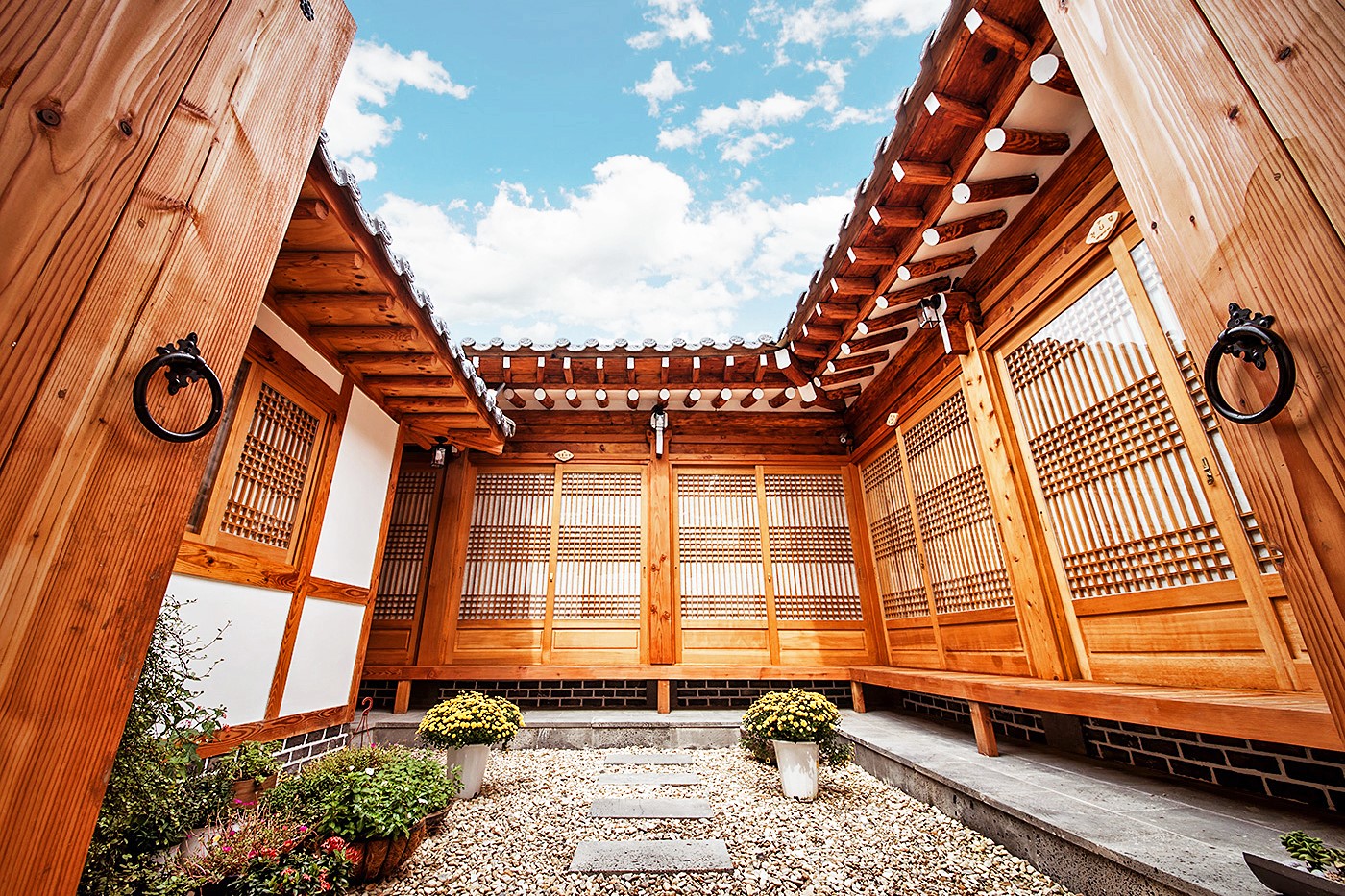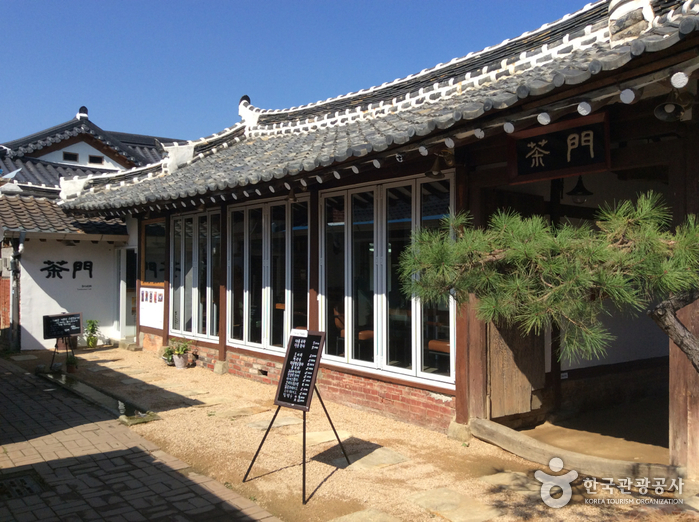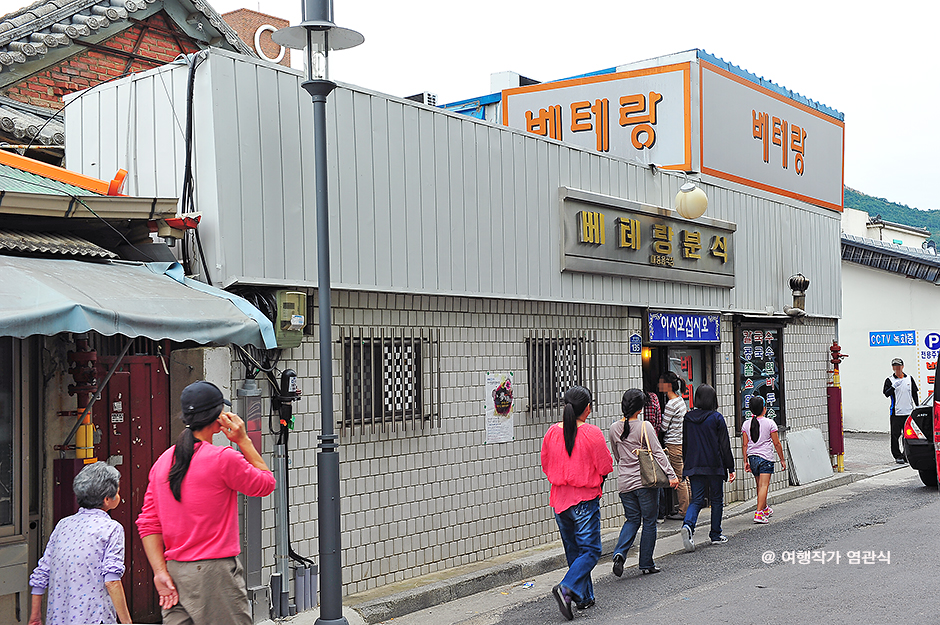Hakindang [Korea Quality] / 학인당 [한국관광 품질인증]
2.7Km 2024-04-06
45, Hyanggyo-gil, Wansan-gu, Jeonju-si, Jeonbuk-do
+82-63-284-9929
Hagindang was built by the same master builder and carpenter who took part in building the palaces. It's the oldest traditional Korean house in Jeonju Hanok Village and a city/province-designated Folklore Heritage No. 8 situated in Hyanggyo-gil. It has a tall gate in the middle of high walls on either side, behind which are a large front yard with a pond as well as trees surrounding the pond. The house behind this pond is in perfect harmony with the landscape. Right next to the tall gate are a detached building called “sarangchae” and an area designated for experiencing Korean tradition, including another detached building called “byeoldangchae” behind the main building named “Hagindang.” Bonchaedaegwan, which consists of three rooms named “Baekbeomjisil,” “Haegongjisil,” and “Injaejisil” exude elegance and grace The “sarangchae” is a stand-alone building with two rooms with an open living room called "daecheong" in between, making it a perfect place for an entire family to stay. The "byeoldangchae" has a total of three rooms, and the first one (Room No. 1) has a tea room with three windows made of thin wooden frames on three sides. Hagindang serves traditional Korean breakfast like the head family.
Gyodonggaon [Korea Quality] / 교동가온 [한국관광 품질인증]
2.7Km 2024-04-07
73-1, Eunhaeng-ro, Wansan-gu, Jeonju-si, Jeonbuk-do
+82-10-5106-3355
Gyodong Gaon is located right in the middle of the main street of Jeonju Hanok Village. The word "gaon" means "middle" in Korean. It's a two-story traditional Korean house that stands out among the rest of the traditional Korean houses in the alley leading to Omokdae. Just inside the gate is a yard with colorful flower trees, jars of sauces, and furnace. The mural on one of the walls is popular among the guests as a place to take photos.
The "numaru", or "loft" in Korean, overlooks the Hanok Village, and is one of the best places in the village to get a closer look at the 500 year old zelkova tree and the foot of the mountain nearby. Open to all the guests, the "numaru" is very popular during the winter as well as the summer. It's an open space with a wooden floor, so it's very cool during the summer, and it also serves as an observatory to enjoy the view of all the snow-covered trees and roofs in the Hanok Village during the winter while having a hot cup of tea.
The owner of the guesthouse has been living here for 37 years. He rebuilt his house and turned it into a hanok guesthouse in 2014 while making sure the rooms are well insulated and comfortable to stay.
He built a two-story building to make an efficient use of the space, and focused on making all the rooms look different. The house has five rooms, and only the “Meomulda Room” on the first floor is the only rooms with a living room separated from the bedroom. All you have to do is open the door to enjoy the view of the yard, Hanok Village, and Omokdae. The “Nanuda Room” on the second floor is the largest one that can accommodate more than five people, making it the most popular choice among families. The "Damda Room" and "Kkumkkuda Room" both have an attic that can be reached by a ladder. The attic is big enough to sleep two adults, and some guests actually sleep there for a unique experience. One of the walls of the attic is finished with cypress wood which has a pleasant scent. The “Geurida Room” has the best view through the two windows on the either side of the room, in addition to warm sunlight and cool wind that come through the window. Modern, not traditional, doors are installed in all the rooms for better sound proofing and insulation.
Gyodong Gaon offers a number of experience programs, such as traditional games like “gulleongsoe”, “tuho", and “Korean top”, As well as “sabang chigi”, “sampalseon”, and “ttangttameokgi”.
Many Korean adults are familiar with these games, while children and foreigners can find these games interesting. All these traditional Korean games are free to play.
Jeonggahanog / 정가한옥
2.7Km 2025-03-05
78-3, Girin-daero, Wansan-gu, Jeonju-si, Jeonbuk-do
+82-10-9934-1300
Jeongga Hanok is a space where the traditional beauty of hanok and the modern comfort co-exists. The newly built Hanok is neat and pleasant. When you enter the small cobbled yard, the porch and the eaves will welcome you, and you’ll find that the rooms are filled with delicate wood fragrance. The interior is furnished with Korean cypress trees and red clay. In particular, the Cypress Tree room is all made of cypress trees, from the walls to the ceiling, making guests feel like they are lying in a forest. Maple Room and Ginkgo Tree Room, meanwhile, have attics.
Jeongga Hanok faces Jeonju Hanok Village with the Girin-daero in the middle. Hanok Village is just across the road. Major attractions such as Gyeonggijeon, Jeondong Catholic Cathedral, and Jeonjuhyanggyo Confucian School are all within walkable distance. Omokdae, which offers an unhindered view of Hanok Village, is located over the pedestrian overpass. Jaman Mural Village, famous for colorful mural and cozy cafes, is about 300 meters away and a great spot for selfie lovers.
Damun (다문)
2.8Km 2024-04-07
74-8, Eunhaeng-ro, Wansan-gu, Jeonju-si, Jeonbuk-do
+82-63-288-8607
Situated in Jeonju Hanok Village, Gyo-dong, Jeonju-si, Damun serves Korean table d’hote in a restaurant divided into large and small rooms within a hanok building structure.
Yeohangga [Korea Quality] / 여행가 [한국관광 품질인증]
2.8Km 2024-04-07
74-11, Eunhaeng-ro, Wansan-gu, Jeonju-si, Jeonbuk-do
+82-63-231-3040, +82-10-7742-6738
Yeohangga is a guesthouse owned and run by a woman who majored in early childhood education and who has been teaching children for over 20 years. The name means "A home for a happy trip," she says. It’s a unique guesthouse since the owner offers various traditional educational games. The cozy and comfortable guesthouse is a traditional Korean house built in March 2013 at a site where an old house used to be. The main building and detached building are divided by the ridge of the roof with beautiful rafters. There is another meaning to the name of the guesthouse: "a house where the woman is happy." She named it as such for a good reason. She used to live in Seoul when her parents advised her to move to Jeonju and run a guesthouse, leaving her husband and child behind. At first, she considered accepting only female guests, but it wasn't an option since most of the people visiting Jeonju are couples and groups of friends. Instead, she made sure the guesthouse is safe for women while building the house. Many female tourists traveling alone find this a great feature of the guesthouse because they feel safer during their stay. For one, she installed three doors for the rooms (1 transparent door, 1 opaque glass door, and a traditional Korean door). Not only do the guests feel safer; the rooms are also well-insulated thanks to the triple doors. The floors and walls are covered with traditional Korean paper coated with soybean oil, which is very environment-friendly. In the four rooms named “Spring,” “Summer,” “Autumn,” and “Winter,” there are many toys and materials for traditional Korean cognition games, such as “Chilgyo Game,” “Gonu Game,” and “Mabangjin.” It’s very likely that even Koreans have never heard of these games. The owner of the guesthouse chose these games specifically because they are perfect for children to play in a traditional Korean house. She teaches her little guests how to play the games. “Chilgyo Game” involves making a shape with 7 to 20 pieces, whereas “Gonu Game” is similar to the game of Chinese chess. "Mabangjin" is a type of IQ game that involves laying down a total of nine different numbers in three rows and columns so that the sum of the three numbers is identical when added horizontally, vertically, or diagonally. Many guests find these games interesting, and the owner of the guesthouse finds joy in teaching these games to as many families as possible. She recently took over another traditional Korean guesthouse called "Samrakheon" near the Jeonju Oriental Medicine Center. It's a stand-alone guesthouse for groups and families, and she uses the place to teach traditional games to more people.
The Hanok [Korea Quality] / 더 한옥 [한국관광 품질인증]
2.8Km 2024-04-07
68-15, Eunhaeng-ro, Wansan-gu, Jeonju-si, Jeonbuk-do
+82-10-2189-4002
The Hanok was transformed into a new style of hanok by combining the traditional structure (built in 1975) with a modern hanok style. Located in Jeonju Hanok Village, this large hanok is composed of a ‘ㄱ’-shaped bonchae (main building, 7-kan*), a sarangchae (men’s quarters, 3-kan), a large courtyard, and a platform for crocks of sauces and condiments. The house accepts only a limited number of people so that guests can enjoy a relaxing stay amid a pleasant, spacious environment.
Each room is built with “well-being” construction materials such as Hinoki cypress wood, red clay, and hanji (traditional Korean paper handmade from the mulberry tree). As for the four rooms of the anchae (women’s quarters), ‘Gwibin’, the largest room, is suitable for two families. It is heated with the ondol system (Korean floor heating system), and has a body massager and two king-sized beds. ‘Eoulim’ has an attic and a high ceiling with exposed rafters and crossbeams. Both rooms are equipped with two bathrooms.
The ‘ㅡ’-shaped sarangchae opposite the courtyard has three guestrooms. In particular, ‘Byeolhana’ has a red clay bed with ondol heating; while ‘Byeolset’ features a bunkbed made of wooden materials originally used in the construction of the house.
The Hanok provides a ‘Moonlight tea meeting’ where guests can enjoy tea and conversation under the moonlight in the large courtyard.
*kan - a unit of measurement referring to the distance between two columns.
Bukyungdang [Korea Quality] / 부경당 [한국관광 품질인증]
2.8Km 2024-04-07
99-5, Hanji-gil, Wansan-gu, Jeonju-si, Jeonbuk-do
+82-10-5327-8736
Located at the heart of the Jeongju Hanok Village, Bugyeongdang is a beautiful traditional 60-year old Hanok.
Traditional floor, roof tiles, and jar stands next to stone walls, while small garden and flower beds reflect the architect couple's attentive hands. As a Hanok with one of the prettiest gardens in Jeonju Hanok Village, it is a good place to appreciate the garden flowers and enjoy the unique laid-back atmosphere of Hanok while sitting on the floor. The place is close to major tourist attractions including Imokdae, Gyeonggijeon, Jeondong Catholic Cathedral, and Hyanggyo.
The owner, who was born and raised in the Jeonju Hanok Village, describes must-go sites like a tour guide and introduces undiscovered great restaurants or things-to-do to the guests. As the owner, who had long been engaged in architecture, takes care of the Hanok, the building always stays clean and in good condition.
In the shared kitchenette, guests can prepare simple breakfast for themselves with the dishes and cups made by the wife of the owner herself. Luggage storage services before check-in and after check-out, and description of tourist attractions are provided.
Dan Kyung [Korea Quality] / 단경 [한국관광 품질인증]
2.8Km 2024-04-07
99, Hanji-gil, Wansan-gu, Jeonju-si, Jeonbuk-do
+82-10-5304-4380
Beginning of brightness that is what Hanok Guesthouse Dankyung means. The name reflects the politeness and consideration of the people of Jeonju. It also carries the wish for the guests of the guesthouse to become polite and considerate as well.
Since it was built in June 1943, Dankyung has kept its original form intact through the turbulent period of Korea's liberation from Japanese colonization, Korean War, and modernization. Despite the traditional form, the approximately 70-year-old Hanok is convenient to use and is beautiful in shape, emitting its beauty and gracefulness to the visitors of Jeonju Hanok Village. Anyone staying in Dankyung will feel as if he/she has become a noble man/woman of old Korea.
The white birch garden at the entrance, maple tree, and apricot flower tree in the yard create a seasonal atmosphere. Dansil, Hyangsil, and Gyeongsil of the main building and Byeolsil and Dasil of the separate building are equipped with a wooden floor, giving off a delicate wood scent. The gallery opposite the garden displays artworks and provides a space for guests to have breakfast or drink coffee or tea. The rooftop of the gallery is a special place for guests so that they can enjoy an uninterrupted view of Jeonju Hanok Village over drinks.
Veteran Kalguksu (베테랑칼국수)
2.8Km 2024-08-12
135 Gyeonggijeon-gil, Wansan-gu, Jeonju-si, Jeonbuk-do
Veteran Kalguksu, located in Jeonju Hanok Village, has been operating since 1977, attesting to the great taste of their broth, made using sesame, meal, and eggs. The noodles are also cut much thinner than other restaurants, while maintaining their chewy texture. Another popular menu at the restaurant is their kongguksu.
GaEunChae 2 (가은채2)
2.8Km 2025-07-10
100-20, Hanji-gil, Wansan-gu, Jeonju-si, Jeonbuk-do
Gaeunchae 2 is the sister hanok of Gaeunchae in Jeonju Hanok Village, Jeollabuk-do. It’s a traditional red clay-walled hanok with ondol underfloor heating, exposed roof beams and hanji wallpaper and flooring - creating a beautiful and distinctive hanok interior. It has a small hallway which is good for storing luggage or just to sit and chat. In the garden are sculpted stone lanterns and tigers. Local attractions such as Jeondong Cathedral and Gyeonggijeon Shrine are a short walk away.

![Gyodonggaon [Korea Quality] / 교동가온 [한국관광 품질인증]](http://tong.visitkorea.or.kr/cms/resource/75/2049675_image2_1.jpg)


![Yeohangga [Korea Quality] / 여행가 [한국관광 품질인증]](http://tong.visitkorea.or.kr/cms/resource/63/2572563_image2_1.jpg)
![The Hanok [Korea Quality] / 더 한옥 [한국관광 품질인증]](http://tong.visitkorea.or.kr/cms/resource/68/2556468_image2_1.jpg)
![Bukyungdang [Korea Quality] / 부경당 [한국관광 품질인증]](http://tong.visitkorea.or.kr/cms/resource/29/2593529_image2_1.jpg)
![Dan Kyung [Korea Quality] / 단경 [한국관광 품질인증]](http://tong.visitkorea.or.kr/cms/resource/65/2593265_image2_1.jpg)

 Español
Español
 한국어
한국어 English
English 日本語
日本語 中文(简体)
中文(简体) Deutsch
Deutsch Français
Français Русский
Русский